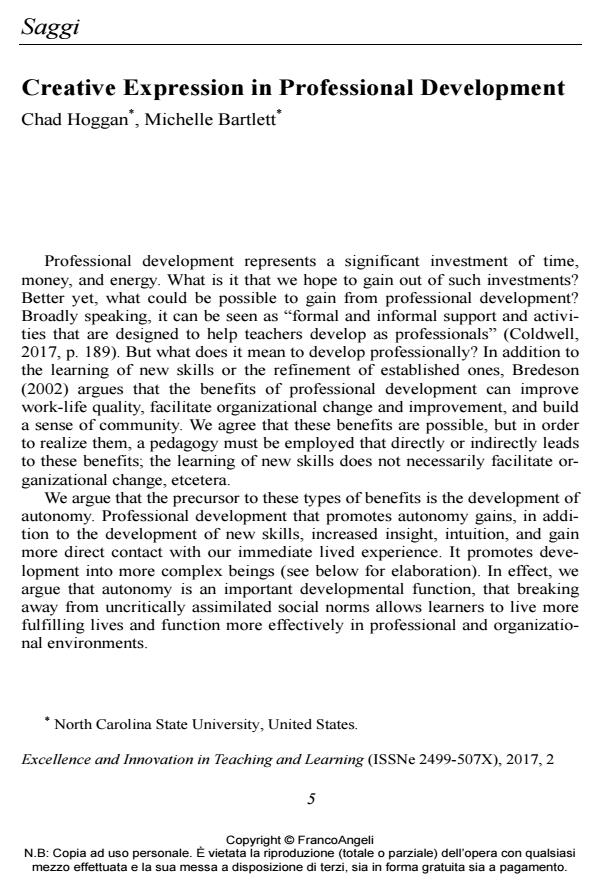Creative Expression in Professional Development
Journal title EXCELLENCE AND INNOVATION IN LEARNING AND TEACHING
Author/s Chad Hoggan, Michelle Bartlett
Publishing Year 2017 Issue 2017/2 Language English
Pages 11 P. 5-15 File size 163 KB
DOI 10.3280/EXI2017-002001
DOI is like a bar code for intellectual property: to have more infomation
click here
Below, you can see the article first page
If you want to buy this article in PDF format, you can do it, following the instructions to buy download credits

FrancoAngeli is member of Publishers International Linking Association, Inc (PILA), a not-for-profit association which run the CrossRef service enabling links to and from online scholarly content.
Educational theorists have long touted the developmental benefits of engaging in creative endeavors, such as photography, creative writing, and so forth, yet few professional development programs incorporate creative expression into their curricula. This article briefly reviews the work of Fromm, Marcuse, Jung, and Heron to explore possible justifications and explanations of the developmental and organizational benefits that are possible from creative expression. This article argues that a unifying premise of these theorists is that creative expression promotes autonomy. It concludes by providing an example of how a pedagogy utilizing creative expression can meet immediate learning objectives in addition to the longer term outcome of increased autonomy and discusses how such pedagogies can be incorporated into professional development programs.
Keywords: Professional development; creative expression; autonomy; arts; organizational learning
- Argyris, C. (1976). Single-loop and Double-loop Models in Research on Decision-making. Administrative Science Quarterly, 21, 363-375. DOI: 10.2307/2391848
- Bredeson, P. V. (2002). The Architecture of Professional Development: Materials, Messages and Meaning. International Journal of Educational Research, 37 (8), 661-675. DOI: 10.1016/S0883-0355(03)00064-8
- Brookfield, S. D. (2005). The Power of Critical Theory: Liberating Adult Learning and Teaching. San Francisco: Jossey-Bass.
- Burke, W. W. (2017). Organization Change: Theory and Practice, Fifth edition. Thousand Oaks (CA): Sage Publications.
- Butterwick, S., & Roy, C. (2017). Voice and Engagement: The Power of Arts-Based Adult Learning. In Conceição, S. C. O., Martin, L. G., & Knox, A. B. (Eds.), Map-ping the Field of Adult and Continuing Education: An International Compendium (pp. 197-200). Sterling (VA): Stylus Publishing
- Candy, P. C. (1991). Self-direction for Lifelong Learning: A Comprehensive Guide. San Francisco: Jossey-Bass. DOI: 10.1177/074171369204200307
- Chai, J. X., & Fan, K. K. (2017). Constructing Creativity: Social Media and Creative Expression in Design Education. Eurasia Journal of Mathematics, Science and Technology Education, 14 (1), 33-43.
- Coldwell, M. (2017). Exploring the Influence of Professional Development on Teacher Careers: A Path Model Approach. Teaching and Teacher Education, 61, 189-198.
- Dirkx, J. M. (2000). After the Burning Bush: Transformative Learning as Imaginative Engagement with Everyday Experience. Paper presented at the International Transformative Learning Conference, Teachers College, Columbia University.
- Francis, C. A. (1984). Organizational Influences on Creative Insight and Quality in a Research and Development Environment. Case Western Reserve University, Cleve-land (OH).
- Fromm, E. (1941). Escape from Freedom. New York (NY): Holt, Rinehart and Winston.
- Fromm, E. (1961). Marx's Concept of Man. New York: Frederick Ungar.
- Fromm, E. (1965). The Application of Humanist Psychoanalysis to Marx's Theory. In E. Fromm (Ed.), Socialist Humanism: An International Symposium (pp. 228-245). Garden City (NY): Doubleday.
- Greene, M. (1995). Releasing the Imagination: Essays on Education, the Arts, and Social Change. San Francisco: Jossey-Bass.
- Heron, J. (1992). Feeling and Personhood: Psychology in another Key. London-Newbury Park (CA): Sage Publications.
- Hoggan, C., Simpson, S., & Stuckey, H. (2009). Creative Expression in Transformative Learning: Tools & Techniques for Educators of Adults. Malabar (FL): Krieger Publishing.
- Jung, C. G. (1983). The Essential Jung: Selected Writings. Princeton (NJ): Princeton University Press (Original works published between 1902 and 1962).
- Kaplan, B., & Kaiser, R. (2006). The Versatile Leader: Make the most of Your Strengths without overdoing it. San Francisco: Pfeiffer.
- Kegan, R. (1982). The Evolving Self: Problem and Process in Human Development. Cambridge: Harvard University Press.
- Leatherman, D. (2000). Quality Leadership Skills: Standards of Leadership Behavior. League City (TX): International Training Consultants.
- Marcuse, H. (1972). Counterrevolution and Revolt. Boston: Beacon Press.
- Marcuse, H. (1969). An Essay on Liberation, Boston: Beacon Press.
- Navarre Cleary, M., & Breathnach, C. (2017). Competency‐based education as a force for equity. The Journal of Competency-Based Education, 2 (1).
- Richards, R. (Ed.). (2007). Everyday Creativity and new Views of Human Nature: Psychological, Social, and Spiritual Perspectives. San Francisco: American Psychological Association. DOI: 10.1037/11595-000
- Stroupe, R., Rundle, C., & Tomita, K. (2016). Developing autonomous learners in Japan: Working with teachers through professional development. Language Learner Autonomy: Teachers’ Beliefs and Practices in Asian Contexts, 43-61.
- Swanson, R. A., & Holton, E. F. (2001). Foundations of human Resource Develop-ment. San Francisco: Berrett-Koehler Publishers.
Chad Hoggan, Michelle Bartlett, Creative Expression in Professional Development in "EXCELLENCE AND INNOVATION IN LEARNING AND TEACHING" 2/2017, pp 5-15, DOI: 10.3280/EXI2017-002001